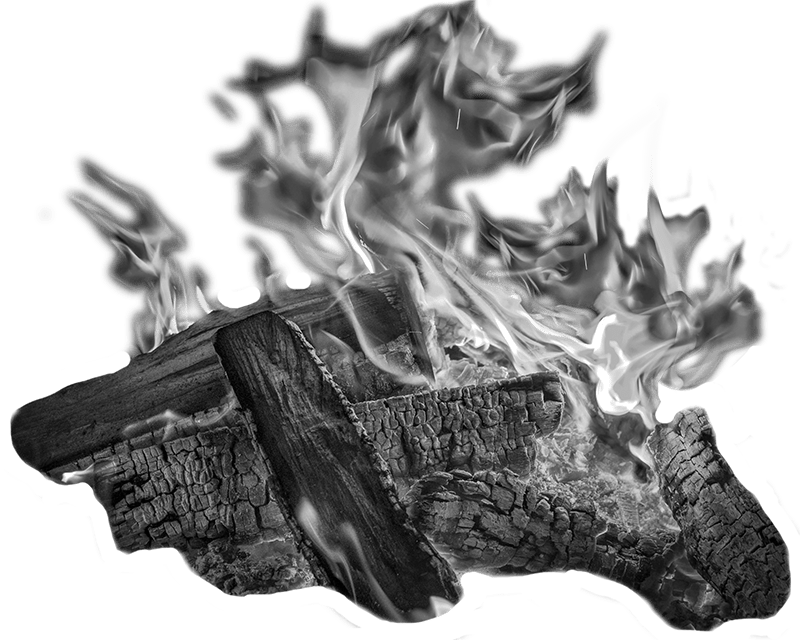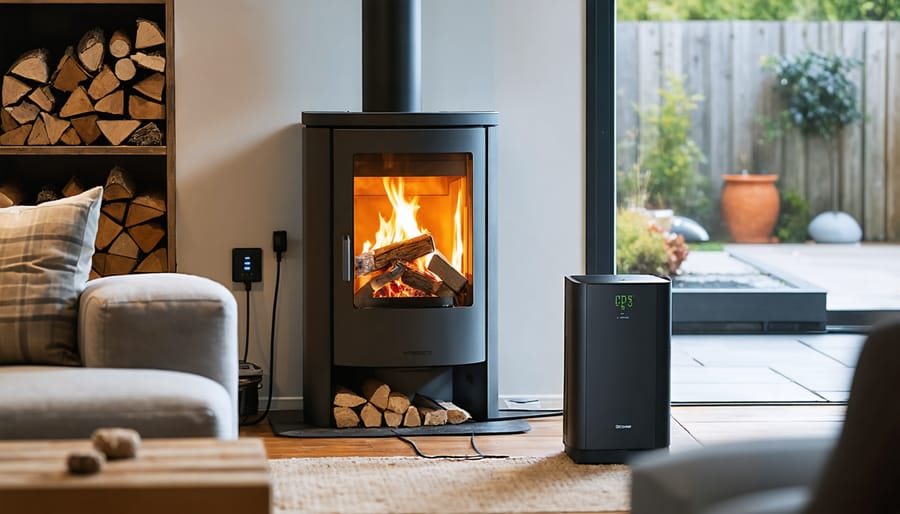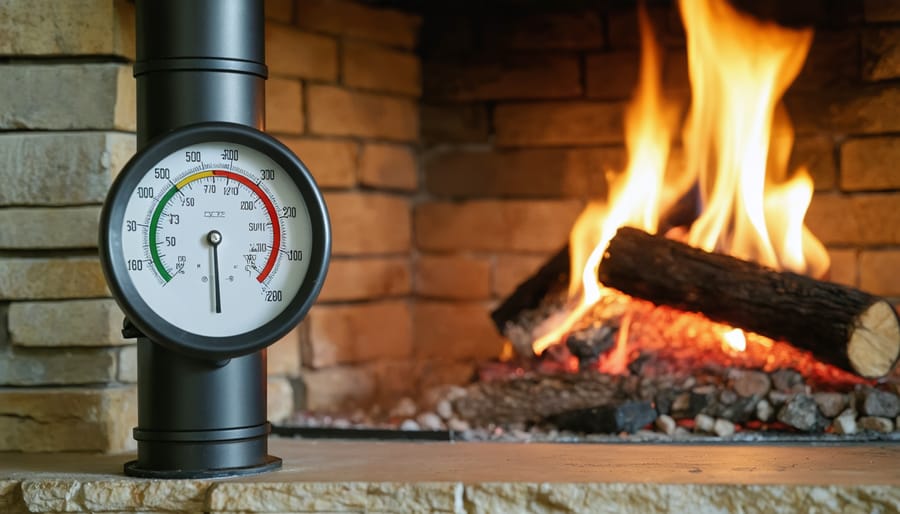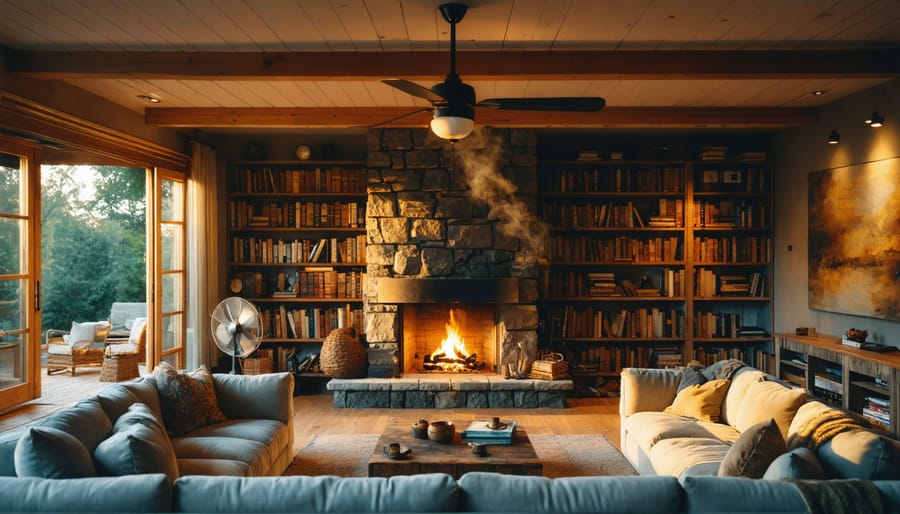Understand your pellet stove’s electrical footprint before you buy or optimize what you already own. These appliances typically consume 100-200 watts during operation—comparable to running two standard light bulbs—which translates to roughly $10-$20 monthly in added electricity costs for average use. This modest power requirement drives essential components: the auger feed system, combustion blower, convection fan, and control board that regulates your stove’s performance.
Calculate your actual costs by multiplying your stove’s wattage by daily runtime hours, then by your local electricity rate. A 150-watt stove running eight hours daily at $0.13 per kilowh costs approximately $4.68 monthly. Factor in startup cycles too—pellet stoves draw 300-500 watts during their 10-15 minute ignition phase, similar to comparing gas and electric appliances that have varying startup demands.
Balance this electricity expense against pellet fuel efficiency. Modern pellet stoves convert 70-83% of fuel into usable heat, outperforming traditional wood stoves while maintaining precise temperature control. The electrical investment enables automated feeding, consistent burns, and programmable thermostats—features impossible with purely manual systems.
Consider battery backup systems if power outages concern you. Most pellet stoves become inoperable without electricity, unlike their wood-burning counterparts. Investing in an uninterruptible power supply or generator ensures continuous heating during emergencies while protecting your eco-friendly heating investment year-round.
How Pellet Stoves Actually Use Electricity

The Four Power-Hungry Components
Understanding what makes your pellet stove tick electrically helps you appreciate both its efficiency and running costs. Unlike traditional wood stoves that operate entirely off-grid, pellet stoves rely on four key electrical components working in harmony to deliver consistent, comfortable heat to your home.
**The Auger Motor** serves as your stove’s feeding system, steadily moving pellets from the hopper into the burn pot. This hardworking component typically draws between 50-80 watts during operation. Think of it as the heart that keeps fuel flowing at just the right pace for optimal combustion.
**The Combustion Blower** (or exhaust fan) might be your stove’s most power-hungry element, consuming 80-150 watts. It creates the draft necessary for efficient burning and safely vents exhaust gases outside. This blower runs continuously whenever your stove is operating, making it a significant contributor to overall electricity use.
**The Convection Blower** distributes warmth throughout your living space, circulating heated air from the stove into your room. Drawing 75-125 watts, this fan determines how effectively your pellet stove heats your home. Many models let you adjust fan speed based on your comfort preferences.
**The Control Panel** manages everything electronically, from ignition sequences to temperature settings. While this digital brain uses relatively little power—typically 5-10 watts—it’s essential for your stove’s automated convenience.
Combined, these components use considerably less electricity than many watts household appliances use, making pellet stoves surprisingly economical despite their electrical dependence.
Startup vs. Running Power Demands
Understanding your pellet stove’s electricity usage patterns can help you better manage your energy costs and avoid surprises on your monthly bill. The most significant power draw happens during startup, when your stove works hardest to get your cozy fire going.
During ignition, your pellet stove experiences a temporary power surge, typically drawing between 300-500 watts for about 5-10 minutes. This is when the igniter heats up to light the pellets and the auger and fans kick into high gear to establish proper combustion. Think of it like turning on your oven—there’s an initial burst of energy to reach the desired temperature.
Once your stove settles into steady-state operation, the electricity demand drops considerably to around 50-150 watts. At this stage, the igniter shuts off, and only the auger feeding pellets and the circulation fans continue running. This is when your pellet stove becomes remarkably efficient as an eco-friendly heating solution.
This fluctuation is completely normal and actually demonstrates your stove’s smart energy management. The key takeaway? Most of your electricity cost comes from those startup moments, so frequent on-off cycles will consume more power than letting your stove run steadily during cold days.
The Real Cost: Calculating Your Pellet Stove’s Electric Usage

Average Monthly Electricity Costs
Let’s talk real numbers, because understanding what you’ll actually spend each month helps you make confident decisions about your home heating investment.
For typical 8-hour daily operation during the heating season, most pellet stoves consume between 1.5 to 3 kWh of electricity per day. Using the national average electricity rate of $0.16 per kWh, that translates to roughly $7 to $14 per month. If you live in the Northeast where rates average around $0.22 per kWh, expect monthly costs between $10 and $20. Meanwhile, homeowners in the Pacific Northwest enjoying rates near $0.10 per kWh might see just $5 to $9 monthly.
Running your pellet stove continuously for round-the-clock warmth naturally increases costs. At 24/7 operation, you’re looking at 4.5 to 9 kWh daily, bringing monthly expenses to approximately $22 to $43 nationally. Northeastern homeowners would see $30 to $60, while those in lower-rate regions might pay $14 to $27.
Here’s the encouraging part: even with constant operation, electricity typically represents only 15-20% of your total pellet stove operating costs. The pellets themselves remain your primary expense, making these eco-friendly heating solutions remarkably economical compared to traditional oil or propane systems.
Your actual costs depend on your stove’s specific wattage, local electricity rates, and how efficiently you operate the unit. Most homeowners find that the electricity expense is a small price to pay for the cozy, sustainable warmth pellet stoves deliver throughout those chilly months.
Hidden Electricity Drains You’re Probably Missing
Even if you’ve calculated your pellet stove’s basic electricity consumption, several sneaky culprits might be padding your electric bill without you realizing it. Let’s uncover these hidden drains so you can truly optimize your heating costs.
**Standby power** is often the biggest offender. Many pellet stove owners don’t realize their unit continues drawing electricity even when not actively heating. That digital control panel, the circuit board waiting for your next command, and electronic components can consume 3-15 watts continuously. Over a month, this seemingly trivial amount can add 2-10 kWh to your bill—completely wasted energy when you’re not even enjoying the warmth.
**Thermostat cycling** creates another overlooked expense. If your thermostat settings are too sensitive or poorly calibrated, your stove’s igniter and fans kick on and off repeatedly throughout the day. Each startup cycle demands a surge of electricity, particularly during that 3-5 minute ignition phase. Optimizing your thermostat’s temperature differential can reduce these cycles significantly.
**Inefficient fan settings** represent the third hidden drain. Running your distribution or convection fans on high when medium would suffice wastes considerable power. Similarly, leaving fans running longer than necessary after the fire dies down means you’re circulating air without generating heat—pure electrical waste.
The good news? Addressing these issues is straightforward. Consider unplugging your stove during warmer months, adjust thermostat sensitivity, and experiment with lower fan speeds to find your efficiency sweet spot while maintaining comfort.
Pellet Stoves vs. Other Heating Options: The Energy Efficiency Showdown
Against Pure Electric Heating Systems
When comparing heating options, many homeowners wonder if pellet stoves’ electricity needs make them less efficient than electric heating systems or traditional gas or electric heating. The numbers tell a compelling story in favor of pellet stoves.
Let’s break down the real costs. A typical pellet stove uses about 100 watts of electricity during operation—roughly the same as a standard light bulb. Meanwhile, pure electric heating systems often consume 1,500 watts or more per hour. When you factor in pellet fuel costs against electricity rates, pellet stoves consistently deliver more heat for your dollar.
Consider this practical example: Spending $50 on pellets typically generates around 700,000 BTUs of heat, while the same $50 in electricity might only produce 300,000 BTUs. Even when you add the minimal electricity costs to run the pellet stove’s components, you’re still getting more than double the heating value per dollar spent.
The eco-friendly advantage sweetens the deal further. Pellets are made from compressed sawdust and wood waste—renewable resources that would otherwise end up in landfills. You’re essentially getting superior efficiency while making an environmentally conscious choice that supports sustainable forestry practices.
For homeowners seeking both comfort and cost-effectiveness, pellet stoves represent a smart middle ground that combines modern convenience with remarkable efficiency, making that small electric requirement well worth the investment.
The Eco-Friendly Angle: Carbon Footprint Comparison
When you’re weighing the environmental impact of your heating choices, pellet stoves present an interesting middle ground that’s worth understanding. While they do require electricity to operate, their overall carbon footprint tells a surprisingly positive story compared to purely electric heating systems.
Here’s the thing: pellet stoves use minimal electricity—typically between 100-200 watts during operation—which is about the same as running a couple of light bulbs. The real environmental advantage comes from their primary fuel source. Wood pellets are made from compressed sawdust and agricultural waste, making them a renewable resource that would otherwise end up in landfills. When pellets burn, they release roughly the same amount of carbon dioxide that the trees absorbed during their growth, creating what’s essentially a closed carbon loop.
Compare this to all-electric heating systems like baseboard heaters or electric furnaces, which can draw 1,500-5,000 watts continuously. The electricity powering these systems typically comes from the grid, where fossil fuels still dominate in many regions. Unless you’re fortunate enough to live in an area with predominantly renewable electricity sources, your all-electric heating carries a significantly larger carbon footprint.
The environmental equation becomes even more favorable when you consider efficiency. Pellet stoves convert about 70-83% of their fuel into usable heat, while the journey from power plant to your home through transmission lines loses considerable energy along the way.
For eco-conscious homeowners, pellet stoves offer a practical way to reduce your heating-related emissions while maintaining a cozy, inviting living space. They represent a smart compromise between traditional wood-burning romance and modern environmental responsibility—embracing sustainability without sacrificing the warmth and ambiance that makes a house feel like home.
Smart Ways to Reduce Your Pellet Stove’s Electricity Consumption
Optimize Your Fan and Feed Settings
Finding the sweet spot between comfort and electricity consumption doesn’t have to be complicated. Your pellet stove’s blower fan and pellet feed rate are the two key players in this balancing act, and adjusting them thoughtfully can significantly reduce your electric bill without sacrificing warmth.
Start by experimenting with your blower speed settings. Most pellet stoves offer multiple fan speeds—low, medium, and high. While cranking the fan to maximum pushes more heat into your room faster, it also draws considerably more electricity. Try running your blower on a lower setting once your space reaches your desired temperature. You’ll maintain comfort while using 30-40% less electricity than running at full blast.
The pellet feed rate works hand-in-hand with your blower settings. This controls how many pellets drop into the burn pot per cycle. A higher feed rate means more heat but also requires stronger airflow, which increases both electricity use and pellet consumption. During milder weather or well-insulated spaces, reduce your feed rate to the minimum needed for comfortable warmth.
Think of it as fine-tuning your home’s heating personality. Many homeowners find their ideal efficiency zone by setting both the feed rate and blower to medium during the coldest hours, then dropping to low settings during moderate conditions or overnight. This eco-friendly approach maximizes the renewable energy benefits of pellet fuel while keeping your electricity consumption minimal—creating a truly sustainable heating solution that works beautifully with your lifestyle.
Maintenance Habits That Lower Electric Bills
Just like any heating system, your pellet stove performs best when you show it a little love through consistent maintenance. The beauty is that these simple habits don’t just keep your stove running smoothly—they actually help it use less electricity while heating more effectively.
Start with regular cleaning of your burn pot and ash pan. When ash builds up, your stove’s combustion fan works overtime trying to push air through the blockage, drawing more power than necessary. A quick five-minute cleaning every few days prevents this strain and keeps those electrical components humming efficiently. Similarly, keep your heat exchanger tubes clear—dirty tubes force your circulation fan to run longer to distribute the same amount of warmth.
Your venting system deserves attention too. A partially blocked vent makes exhaust fans labor harder, increasing electricity consumption while reducing heat output. Inspect and clean your vent pipe seasonally to maintain optimal airflow.
Don’t overlook the sensors and moving parts that make your stove smart. Dusty sensors can trigger unnecessary auger cycles, while a poorly lubricated auger motor draws excess current. Check gaskets around doors and hoppers too—air leaks make fans compensate by running longer cycles.
These maintenance routines take minimal time but deliver maximum efficiency. Your stove uses less electricity, heats better, and lasts longer—a win for both your comfort and your wallet while supporting eco-friendly heating practices.
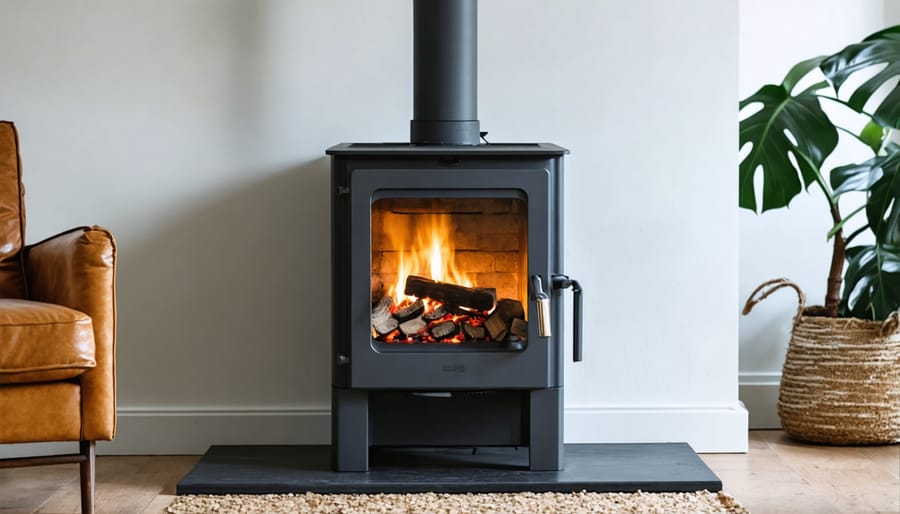
What Happens When the Power Goes Out?
One of the most important considerations for pellet stove owners is understanding what happens during a power outage. Unlike traditional wood stoves that operate independently, your pellet stove will stop working when the electricity goes out. The auger won’t feed pellets, the combustion blower won’t exhaust fumes, and any existing flames will gradually die out. This means losing your primary heat source precisely when you might need it most during winter storms.
The good news? You have several practical solutions to keep your home warm even when the grid fails.
**Battery Backup Systems** offer the most seamless solution for pellet stove owners. These specialized units automatically kick in during outages, providing several hours to even a full day of operation depending on battery capacity. Most systems range from 6 to 24 hours of runtime, giving you peace of mind during brief interruptions. Installation is typically straightforward, and many homeowners find the investment worthwhile for uninterrupted comfort.
**Generators** provide another reliable option, whether portable or whole-home systems. A portable generator can power your pellet stove along with other essential appliances, though you’ll need to ensure proper outdoor placement and ventilation. Whole-home generators offer automatic switching and extended runtime but come with higher upfront costs. Either way, you’re ensuring your heating system stays operational during extended outages.
**Gravity-Fed Pellet Stoves** represent the ultimate off-grid solution. These innovative designs use gravity to feed pellets rather than electric augers, requiring minimal electricity—sometimes just enough for a small fan. While less common and often pricier upfront, they’re worth considering if you live in areas prone to frequent power interruptions or value energy independence.
For true emergency preparedness, consider your pellet stove as part of a broader backup heating strategy. Some homeowners keep a small supply of seasoned firewood and a simple wood stove as a secondary option, while others invest in backup power specifically to maintain their eco-friendly pellet heating during any situation.
When it comes to the complete energy efficiency picture, pellet stoves emerge as a compelling choice for homeowners seeking both warmth and sustainability. Yes, they do require electricity to operate—typically consuming between 100 and 200 watts during regular operation—but this modest electrical draw rarely undermines their overall efficiency advantage. When you compare the total energy consumption of a pellet stove to all-electric heating systems like baseboard heaters or heat pumps in colder climates, pellet stoves consistently deliver more heat per dollar spent, especially when pellet prices remain reasonable in your area.
The beauty of pellet stoves lies in their dual benefit: they burn a renewable, carbon-neutral fuel source while using minimal electricity to distribute that warmth throughout your living space. This combination makes them an eco-friendly heating solution that aligns perfectly with modern sustainability goals without sacrificing comfort or breaking the bank.
We encourage you to take the time to calculate your personal costs based on your local electricity rates and pellet prices. Run the numbers for your specific situation, then optimize your stove’s settings—adjusting feed rates, fan speeds, and thermostat programming—to find that sweet spot where efficiency meets comfort. By fine-tuning these variables, you’ll discover the perfect balance of cozy warmth, environmental responsibility, and meaningful savings that make pellet stoves such an attractive lifestyle element for today’s conscious homeowner.
